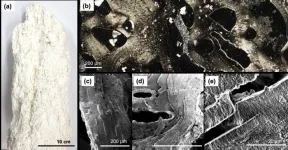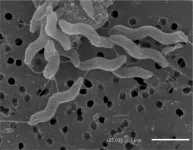(Press-News.org) The hype surrounding machine learning, a form of artificial intelligence, can make it seem like it is only a matter of time before such techniques are used to solve all scientific problems. While impressive claims are often made, those claims do not always hold up under scrutiny. Machine learning may be useful for solving some problems but falls short for others.
In a new paper in Nature Machine Intelligence, researchers at the U.S. Department of Energy’s Princeton Plasma Physics Laboratory (PPPL) and Princeton University performed a systematic review of research comparing machine learning to traditional methods for solving fluid-related partial differential equations (PDEs). Such equations are important in many scientific fields, including the plasma research that supports the development of fusion power for the electricity grid.
The researchers found that comparisons between machine learning methods for solving fluid-related PDEs and traditional methods are often biased in favor of machine learning methods. They also found that negative results were consistently underreported. They suggest rules for performing fair comparisons but argue that cultural changes are also needed to fix what appear to be systemic problems.
“Our research suggests that, though machine learning has great potential, the present literature paints an overly optimistic picture of how machine learning works to solve these particular types of equations,” said Ammar Hakim, PPPL’s deputy head of computational science and the principal investigator on the research.
Comparing results to weak baselines
PDEs are ubiquitous in physics and are particularly useful for explaining natural phenomena, such as heat, fluid flow and waves. For example, these kinds of equations can be used to figure out the temperatures along the length of a spoon placed in hot soup. Knowing the initial temperature of the soup and the spoon, as well as the type of metal in the spoon, a PDE could be used to determine the temperature at any point along the utensil at a given time after it was placed in the soup. Such equations are used in plasma physics, as many of the equations that govern plasmas are mathematically similar to those of fluids.
Scientists and engineers have developed various mathematical approaches to solving PDEs. One approach is known as numerical methods because it solves problems numerically, rather than analytically or symbolically, to find approximate solutions to problems that are difficult or impossible to solve exactly. Recently, researchers have explored whether machine learning can be used to solve these PDEs. The goal is to solve problems faster than they could with other methods.
The systematic review found that in most journal articles, machine learning hasn’t been as successful as advertised. “Our research indicates that there might be some cases where machine learning can be slightly faster for solving fluid-related PDEs, but in most cases, numerical methods are faster,” said Nick McGreivy. McGreivy is the lead author of the paper and recently completed his doctorate at the Princeton Program in Plasma Physics.
Numerical methods have a fundamental trade-off between accuracy and runtime. “If you spend more time to solve the problem, you’ll get a more accurate answer,” McGreivy said. “Many papers didn’t take that into account in their comparisons.”
Furthermore, there can be a dramatic difference in speed between numerical methods. In order to be useful, machine learning methods need to outperform the best numerical methods, McGreivy said. Yet his research found that comparisons were often being made to numerical methods that were much slower than the fastest methods.
Two rules for making fair comparisons
Consequently, the paper proposes two rules to try to overcome these problems. The first rule is to only compare machine learning methods against numerical methods of either equal accuracy or equal runtime. The second is to compare machine learning methods to an efficient numerical method.
Of 82 journal articles studied, 76 claimed the machine learning method outperformed when compared to a numerical method. The researchers found that 79% of those articles touting a machine learning method as superior actually had a weak baseline, breaking at least one of those rules. Four of the journal articles claimed to underperform when compared to a numerical method, and two articles claimed to have similar or varied performance.
“Very few articles reported worse performance with machine learning, not because machine learning almost always does better, but because researchers almost never publish articles where machine learning does worse,” McGreivy said.
The researchers created the image above to convey the cumulative effects of weak baselines and reporting biases on samples. The circles or hexagons represent articles. Green indicates a positive result, for example, that the machine learning method was faster than the numerical method, while red represents a negative result. Column (a) shows what the system would likely look like if strong baselines were used and reporting bias was not an issue. Column (b) depicts the likely results without reporting bias. Column (c) shows the actual results seen in the published literature. (Image credit: Nick McGreivy)
McGreivy thinks low-bar comparisons are often driven by perverse incentives in academic publishing. “In order to get a paper accepted, it helps to have some impressive results. This incentivizes you to make your machine learning model work as well as possible, which is good. However, you can also get impressive results if the baseline method you’re comparing to doesn’t work very well. As a result, you aren’t incentivized to improve your baseline, which is bad,” he said. The net result is that researchers end up working hard on their models but not on finding the best possible numerical method as a baseline for comparison.
The researchers also found evidence of reporting biases, including publication bias and outcome reporting bias. Publication bias occurs when a researcher chooses not to publish their results after realizing that their machine learning model doesn’t perform better than a numerical method, while outcome reporting bias can involve discarding negative results from the analyses or using nonstandard measures of success that make machine learning models appear more successful. Collectively, reporting biases tend to suppress negative results and create an overall impression that machine learning is better at solving fluid-related PDEs than it is.
“There’s a lot of hype in the field. Hopefully, our work lays guidelines for principled approaches to use machine learning to improve the state of art,” Hakim said.
To overcome these systemic, cultural issues, Hakim argues that agencies funding research and large conferences should adopt policies to prevent the use of weak baselines or require a more detailed description of the baseline used and the reasons it was selected. “They need to encourage their researchers to be skeptical of their own results,” Hakim said. “If I find results that seem too good to be true, they probably are.”
This work was completed with funding from DOE grants DE-AC02-09CH11466 and DE-AC02-09CH11466.
END
Replacing hype about artificial intelligence with accurate measurements of success
PPPL researchers find overoptimism in journal articles using machine learning to solve fluid-related partial differential equations
2024-09-25
ELSE PRESS RELEASES FROM THIS DATE:
Researchers harness AI to repurpose existing drugs for treatment of rare diseases
2024-09-25
There are more than 7,000 rare and undiagnosed diseases globally.
Although each condition occurs in a small number of individuals, collectively these diseases exert a staggering human and economic toll because they affect some 300 million people worldwide.
Yet, with a mere 5 to 7 percent of these conditions having an FDA-approved drug, they remain largely untreated or undertreated.
Developing new medicines represents a daunting challenge, but a new artificial intelligence tool can propel the discovery of new therapies from existing medicines, offering hope for patients with rare and neglected conditions and for the clinicians who treat them.
The AI model, called TxGNN, is the first one ...
Combination treatment improves response to immunotherapy for lung cancer
2024-09-25
Francis Crick Institute press release
Under strict embargo: 10:00hrs BST Wednesday 25 September 2024
Peer reviewed
Experimental study
Animals
Combination treatment improves response to immunotherapy for lung cancer
Researchers at the Francis Crick Institute, in collaboration with Revolution Medicines, have tested a combination of treatments in mice with lung cancer and shown that these allow immunotherapies to target non-responsive tumours.
Their findings show that targeting tumours in ...
Nanostructures in the deep ocean floor hint at life’s origin
2024-09-25
Researchers led by Ryuhei Nakamura at the RIKEN Center for Sustainable Resource Science (CSRS) in Japan and The Earth-Life Science Institute (ELSI) of Tokyo Institute of Technology have discovered inorganic nanostructures surrounding deep-ocean hydrothermal vents that are strikingly similar to molecules that make life as we know it possible. These nanostructures are self-organized and act as selective ion channels, which create energy that can be harnessed in the form of electricity. Published Sep. 25 in Nature Communications, the findings impact not only our understanding of how life began, but can also ...
Humbug damselfish use 'motion dazzle' to evade predators
2024-09-25
When thinking of animal camouflage, we typically imagine creatures remaining still, blending seamlessly into their surroundings. But remaining motionless isn’t always practical, and many animals are highly mobile, constantly moving through their environment to graze their food.
New research suggests that high-contrast patterns on animals’ bodies may serve a dual purpose: offering camouflage when stationary, then creating a ‘motion dazzle’ effect when moving, confusing potential predators into misjudging their location – and helping them avoid being ...
Can a drug-free nasal spray protect against deadly respiratory infections?
2024-09-25
New research published in Advanced Materials reports a novel nasal spray for preventing respiratory infections. The spray works by forming a protective coating on the nasal cavity, which captures airborne respiratory droplets and acts as a physical barrier against viruses and bacteria, while effectively neutralizing them.
In studies conducted on mice, the Pathogen Capture and Neutralizing Spray (PCANS) demonstrated up to 8 hours of nasal retention. In a severe Influenza A model, a single pre-exposure dose of PCANS resulted in a greater than 99.99% reduction ...
Do natural disasters jeopardize women’s reproductive health?
2024-09-25
In research published in Brain and Behavior, investigators found increased rates of menstrual irregularities in women living in areas affected by the 2023 earthquake in Turkey.
In the study, 309 women of reproductive age living in regions declared as disaster areas completed online forms 9 months after the earthquake. Responses revealed an increase of menstrual irregularities from 14.3% before the earthquake to 44.8% after the earthquake. Risk factors for menstrual irregularities included post-traumatic stress symptoms, chronic diseases, and smoking.
The findings reveal that reproductive health ...
Can cosmic radiation in outer space affect astronauts’ long-term cognition?
2024-09-25
During missions into outer space, galactic cosmic radiation (GCR) will penetrate current spacecraft shielding and thus pose a significant risk to human health. Previous studies have shown that GCR can cause short-term cognitive deficits in male rodents. Now a study published in the Journal of Neurochemistry reveals that GCR exposure can also cause long-lasting learning deficits in female rodents.
The impact of GCR on cognition was lessened when mice were fed an antioxidant and anti-inflammatory compound called CDDO-EA.
Beyond ...
Do preventive health technologies promote or harm consumers’ wellbeing?
2024-09-25
Preventive health technologies—such as wrist-worn activity trackers or health and fitness apps—are popular tools for promoting wellbeing, but new research published in the Journal of Consumer Affairs reveals that consumer engagement with these technologies can be considered a double-edged sword.
The study, which involved 30 in-depth interviews with users, found that consumers engage with preventive health technologies based on a variety of health goals—for example, to lose weight, improve performance, monitor data of an enjoyable activity, or acquire a healthy routine.
These diverse goals led users ...
Preclinical studies suggest a drug-free nasal spray could ward off respiratory infections
2024-09-25
Researchers from the Brigham detail how the spray they created may offer broad-spectrum protection from respiratory infections by COVID-19, influenza, everyday cold viruses, and pneumonia-causing bacteria
A new study details how a nasal spray formulated by investigators from Brigham and Women’s Hospital, a founding member of the Mass General Brigham healthcare system, may work to protect against viral and bacterial respiratory infections. Based on their preclinical studies, the researchers say the broad-spectrum nasal spray is long-lasting, safe, and, if validated in humans, could play a key role in reducing respiratory diseases ...
Campylobacter jejuni-specific antibody gives hope to vaccine development
2024-09-25
Bacterial infections resulting in enteritis, sometimes extra-intestinal infections such as sepsis, continue to be a global health concern. A leading cause of diarrheal and extra-intestinal infectious mortality among children under 5 and elderly persons is infection with Campylobacter bacteria, against which there is no effective vaccine or medication. An Osaka Metropolitan University-led team has recently uncovered what could be an important step toward preventing, diagnosing, and treating a species of Campylobacter bacteria.
Researchers including Professor Shinji Yamasaki and Associate Professor Noritoshi Hatanaka of the Graduate School ...
LAST 30 PRESS RELEASES:
Interaction of climate change and human activity and its impact on plant diversity in Qinghai-Tibet plateau
From addressing uncertainty to national strategy: an interpretation of Professor Lim Siong Guan’s views
Clinical trials on AI language model use in digestive healthcare
Scientists improve robotic visual–inertial trajectory localization accuracy using cross-modal interaction and selection techniques
Correlation between cancer cachexia and immune-related adverse events in HCC
Human adipose tissue: a new source for functional organoids
Metro lines double as freight highways during off-peak hours, Beijing study shows
Biomedical functions and applications of nanomaterials in tumor diagnosis and treatment: perspectives from ophthalmic oncology
3D imaging unveils how passivation improves perovskite solar cell performance
Enriching framework Al sites in 8-membered rings of Cu-SSZ-39 zeolite to enhance low-temperature ammonia selective catalytic reduction performance
AI-powered RNA drug development: a new frontier in therapeutics
Decoupling the HOR enhancement on PtRu: Dynamically matching interfacial water to reaction coordinates
Sulfur isn’t poisonous when it synergistically acts with phosphine in olefins hydroformylation
URI researchers uncover molecular mechanisms behind speciation in corals
Chitin based carbon aerogel offers a cleaner way to store thermal energy
Tracing hidden sources of nitrate pollution in rapidly changing rural urban landscapes
Viruses on plastic pollution may quietly accelerate the spread of antibiotic resistance
Three UH Rainbow Babies & Children’s faculty elected to prestigious American Pediatric Society
Tunnel resilience models unveiled to aid post-earthquake recovery
Satellite communication systems: the future of 5G/6G connectivity
Space computing power networks: a new frontier for satellite technologies
Experiments advance potential of protein that makes hydrogen sulfide as a therapeutic target for Alzheimer’s disease
Examining private equity’s role in fertility care
Current Molecular Pharmacology achieves a landmark: real-time CiteScore advances to 7.2
Skeletal muscle epigenetic clocks developed using postmortem tissue from an Asian population
Estimating unemployment rates with social media data
Climate policies can backfire by eroding “green” values, study finds
Too much screen time too soon? A*STAR study links infant screen exposure to brain changes and teen anxiety
Global psychiatry mourns Professor Dan Stein, visionary who transformed mental health science across Africa and beyond
KIST develops eco-friendly palladium recovery technology to safeguard resource security
[Press-News.org] Replacing hype about artificial intelligence with accurate measurements of successPPPL researchers find overoptimism in journal articles using machine learning to solve fluid-related partial differential equations





